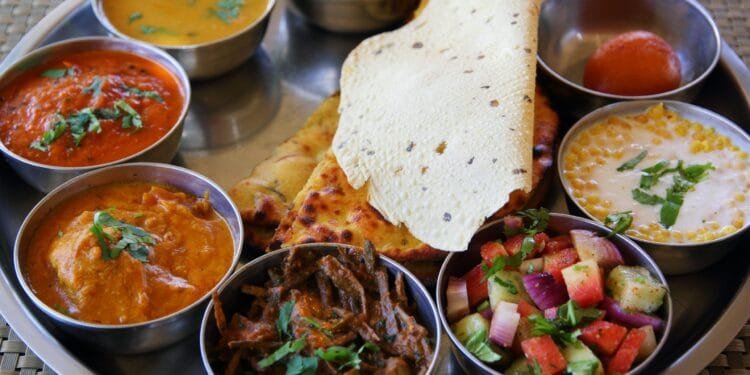India is a diverse country of heritage and culture. With various cultures, comes a variety of rituals, festivals, and cuisines. Traditional cuisines are a real treasure of culinary history because of their diversity, use of seasonal produce, and unique cooking techniques. Not only do traditional foods reflect culture, but they provide essential nutrients. A thali which means ‘A plate’ is a symphony of flavours, colours, and textures that symbolize the rich cultural legacy of India. It is more than just a meal. In addition to being visually appealing, an Indian Thali represents the concepts of a well-rounded meal, displaying a blend of Tradition and Nutrition. (1)

There are no separate courses when it comes to serving traditional Indian cuisine. All of the food is presented at once. An authentic Indian thali is a well-balanced meal, regardless of regional differences. The thali is made wholesome by combining one or two types of grain, lentils, some vegetables, curd or buttermilk, sour chutney or pickle, papad, tempering also known as ‘tadka’, ghee, and spices. These components offer distinct nutrients essential for a balanced diet. It comprises carbohydrates for mainly energy production, proteins that are essential for the growth, repair, and maintenance of body tissues, and healthy fats which are a source of energy while also being important for the absorption of fat-soluble vitamins (A, D, E, K). Other components like vitamins, minerals, fibre, and probiotics are also optimally balanced. (2)

The average calorie content in a vegetarian thali. (3)
Rice (1 cup)– 213 calories
Chapati (2 unit)– 192 calories
Dry vegetable dish (1 cup) – 100 calories
Dal (1 cup) – 106 calories
Curd (1 cup) – 50 calories
Sweet (1 unit) – 150 calories
An average Indian sedentary male weighing 65 kgs requires 2080 kcals, and a female weighing 55 kgs needs 1650 kcals/ day. A complete vegetarian thali can roughly provide 800 kcals for a one-time meal. The remaining calories shall be taken in other meals of the day. A non-vegetarian thali will more or less give the same amounts of calories but will differ largely in protein content, as non-vegetarian items provide a great source of essential amino acids.
The base of traditional diets originates from the regional environment, culture, and agricultural practices. Over the course of centuries, they have changed due to the availability of ingredients and the passing down of cooking skills from one generation to the next. Techniques practiced earlier are also changing with time. For example, earlier side dishes like chutneys used to be prepared on a grinding stone, locally known as ‘Sil Batta’, which gave a different kind of freshness to the dish. This has now been replaced by mixers and grinders.

Whole, unprocessed foods like cereals, fruits, vegetables, legumes, nuts, seeds, and lean proteins are a staple of traditional diets, eating food that is in the season to guarantee freshness and high nutritional content, adding foods that are naturally fermented to promote a healthy gut, customs, and traditions that promote mindful eating and a strong bond with food are all emphasized by Traditional diets. These diets not only honour our culture but also are recognised for showing inherent health benefits. For example, many foods that are currently considered superfoods, like turmeric, chia seeds, amla, and amaranth, have long been staples of traditional diets. (4)
Nutrition is also being affected by changes in eating habits, such as the move from traditional to convenient foods. Traditional staples like bhakri, which were made from millets like jowar, ragi, and bajra, had benefits since they were low in glycaemic index, high in nutrients, and gluten-free. Unfortunately, we no longer use them as much and instead eat common grains like wheat and white rice, which have a high glycaemic response and less nutrient diversity. Speaking of fruits, many people today eat apples and pears after peeling the skin, which lowers the fruit’s fiber level. In the past times, locally cultivated fruits like chickoo, jam, and ber were consumed as they were rich in micronutrients and had a good fiber content. Traditional diets relied more on seasonal, locally sourced vegetables. These include a broad range of leafy greens, root vegetables, and other plant components that offer various nutrient components. These were used not only for cooking vegetables but also for making desserts like gajar halwa and dudhi halwa. Nowadays, carrot sticks have been replaced for this. While carrot sticks may have a high fiber content, they are not able to fully absorb fat-soluble vitamins like vitamin A. Ghee, on the other hand, facilitates the absorption of vitamin A when used in dishes like gajar halwa.
However, nowadays due to various reasons like busy schedules, time constraints, urban lifestyles, changing dietary preferences, and economic constraints having an elaborate meal every time is not possible and convenient. Also providing the required nutrients in optimum amounts is difficult due to the excessive use of chemicals, pesticides, and weather conditions reducing crop quantity as well as affecting quality. While incorporating a traditional Indian thali into everyday meals may present challenges, there are practical solutions to overcome these obstacles. One of the ways is the Fortification of foods. This enhances the nutrient content of the food product by adding certain vitamins and minerals thus improving the composition of an overall meal. Supplementation is another way to provide the body nutrients that it needs which might not be available solely via diet.
A strong idea combining modern nutritional science with the knowledge of our ancestors is nutrition with tradition. The Indian Thali is a perfect fusion of flavour, customs, and nutrition. We can have a varied, nutrient-rich diet that promotes general health and well-being by adopting traditional diets. The principles of traditional diets provide a timeless approach to eating well and maintaining a healthy lifestyle in a world where dietary trends come and go.

References:
- https://www.ncbi.nlm.nih.gov/pmc/articles/PMC10706084/#:~:text=Traditional%20foods%20are%20not%20just,overall%20health%20and%20well%2Dbeing.
- https://mealawe.com/science-behind-indian-thali/
- https://www.im4change.org/upload/files/RDA_short_report%281%29.pdf
- https://en.wikipedia.org/wiki/Indian_cuisine#Hindu_fasting_cuisine




























